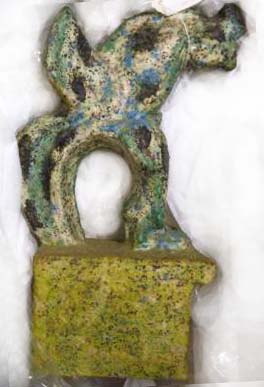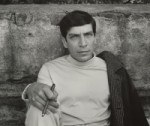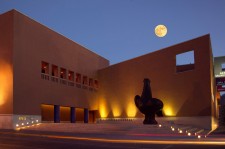


Juan Soriano
Mexican, 1920-2006
Rooster, 1964 ca.
glazed ceramic
12 1/2 x 3 3/4 x 7 1/2 in.
SBMA, Gift of Charles A. Storke
1994.57.34

Soriano photographed by Lola Alvarez Bravo
"Art should reveal something about the human essence, and that is something that goes beyond geographical and cultural borders," he said last year, adding, "I don't really know what being Mexican is, and I am too old now to go about investigating." - Juan Soriano, 2004

Soriano's La Paloma, in front of Museo de Arte Contemporaneo de Monterrey
COMMENTS
Juan Soriano was born in Guadalajara to a middle-class family. Soriano’s father was Rafael Rodríguez Soriano, who fought in the Mexican Revolution and later became a minor politician and, eventually, a spiritist. His mother, Amalia Montoya, who had followed her husband into battle as a "soldadera," or female soldier, kept the house that included Juan's thirteen aunts and four sisters. His precocious talents led him to enter the circle of the renowned artist Jesús Reyes Ferreira, known as "Chucho" Reyes, who introduced Soriano to pre-Columbian and colonial Mexican art as well as art from outside his country. Soriano began exhibiting in Guadalajara at age 14. His first show in the regional museum attracted the attention of such influential Mexican painters as María Izquierdo and José Chávez Morado as well as the photographer Lola Álvarez Bravo, all of whom became close friends of Soriano and urged the young man to travel to Mexico City. The following year (1935), Soriano moved to the Mexican capital and soon entered into a lively visual and personal dialogue with Rivera, Frida Kahlo, Orozco, Siqueiros, as well as the more vanguard artists and writers who composed the famous Contemporáneos group.
Soriano considered the work of all these diverse artists with care, drawing on a deep interest in popular and indigenous arts, as well as the expressive modes derived from Cubism, German Expressionism, and Fauvism as well as the School of Paris artists of the interwar period. In addition, he became acquainted with the imaginative forms of painting that were behind the creations of the European Surrealists who had come as war refugees to Mexico at the end of the 1930s and into the 1940s.
While all of these elements are at play in Soriano's unique works done during these two decades, he cannot be directly connected with any one trend, creating a personal brand of romantic realism. Soriano was also in contact with the most distinguished art dealer of the time, Inés Amor (of the prestigious Galería de Arte Mexicano), who was instrumental in placing Soriano's works in important local and foreign (especially American) collections, and had a pivotal role in the acquisition of Philadelphia's four Soriano paintings (the most extensive collection of works by the artist in the United States).
His first trip to Europe was in 1950, when he moved to Rome for two years. It was in Italy where he developed a passion for sculpture. His first works were in ceramics and terracotta. Back in Mexico he developed new styles achieving artistic maturity, which is further reinforced when, in 1956, he visited Greece and later established himself in Paris.
After 1950, Soriano began several long periods of residence outside Mexico. He experimented with various approaches to abstraction in both painting and sculpture, and also expanded his frame of artistic reference and did extensive set and costume work for the Mexican theatre company "Poesía en Voz Alta." His years spent in Rome and later in Paris definitively changed his art as he absorbed what his life-long friend Rufino Tamayo would call "universalist tendencies."
A retrospective of his work was held in Mexico City in 1983. In 1990 the Museo de Arte Contemporaneo de Monterrey, one of the most important and best-known museums in Mexico commissioned Soriano to make a monumental sculpture, La Paloma (The Dove), to adorn the entrance to the marvelous building designed by renowned architect Ricardo Legorreta. Juan Soriano died on Friday, February 10th, 2006 in Mexico City.
The Juan Soriano and Marek Keller Foundation was born on 2004 aiming to protect the art collection that has been created throughout the years and promote Juan Soriano´s.
http://www.juansoriano.net/biografia/bio2.html
SBMA CURATORIAL LABELS
Juan Soriano, a child prodigy exhibiting by the age of fourteen, became a leading figure in Mexico’s post-revolutionary cultural boom. His early work, primarily figurative paintings with Surrealist leanings, provides a link between the nationalist imagery of the Mexican muralists (which Soriano found too dogmatic) and the experimental vanguard of the 1950s and ’60s known as La ruptura. After moving from his native Guadalajara to Mexico City in 1935, he soon became acquainted with Diego Rivera, Frida Kahlo, Rufino Tamayo, and writer Octavio Paz who would become a lifelong friend.
While in Rome during the early 1950s, Soriano began experimenting with sculpture and abstraction—working in the studio of Pietro and Andrea Cascella. His sculptures often took the form of semi-abstract birds and celestial shapes in variety of materials including ceramic, terracotta, and bronze. El gallo and other early works would later grow into monumental sculptures of fantastical and everyday creatures that can be seen throughout Mexico.
- SBMA title card, 2013
